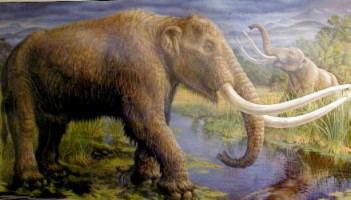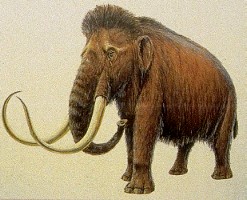 There are just three species of elephant: the African Savanna Elephant, the African Forest Elephant, and the Asian Elephant. Other species have been extinct since the last ice age, which ended about 10,000 years ago. During the Pleistocene Epoch (from 1.5 million to just 10,000 years ago), ice covered much of North America and Europe. Of the giant mammals that existed during this ice age, the mastodon and mammoth were among the largest. Mastodons and mammoths were closely related to today's elephants. The mastodon was shorter than an elephant, but more heavily built, with upward curving tusks. Mammoths ranged in size from a dwarf (1.5 metres tall) to the Imperial mammoth that stood 4.5 metres high at the shoulder; mammoth tusks curved downward. Both mastodons and mammoths were covered in thick brown hair and were vegetarians. They were hunted by humans, which may have been the cause of their disappearance after the end of the ice age
Modern-day elephants are vegetarian mammals, and they are the largest land animals alive today. There are three species: The African (both Forest and Savanna elephant) and the Asian elephant. 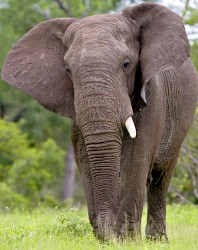 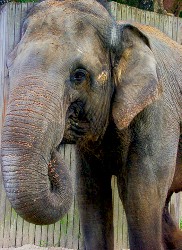
African elephants (left) are usually larger and have bigger ears and longer tusks. African elephants have a sway back, smooth forehead and two 'fingers' at the tip of their trunks. Asian elephants (right) are smaller, with smaller ears and shorter tusks (the female often has none). Asian elephants have an arched back, two humps on the forehead, and have only one trunk 'finger'. As denoted by their names, African elephants are found on the continent of Africa, while Asian elephants are found throughout many Asian countries. More information about each is presented below. African elephants genus Loxodonta, can be found in African countries south of the Sahara Desert. 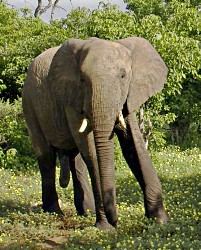
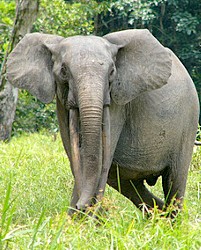 The Savanna elephant (Loxodonta africana, left) is actually the largest of all the elephants. It can grow to over 4 m at the shoulder, and can weigh as much as 7,000 kg. Females are generally smaller. Savanna elephants live in open grasslands, marshes, and near lakeshores.
The Savanna elephant (Loxodonta africana, left) is actually the largest of all the elephants. It can grow to over 4 m at the shoulder, and can weigh as much as 7,000 kg. Females are generally smaller. Savanna elephants live in open grasslands, marshes, and near lakeshores.
The Forest Elephant (Loxodonta cyclotis, right) is less numerous, and can be distinguished by its slightly smaller and rounder ears and thinner, straighter tusks. Forest elephants are generally smaller than Savanna elephants. They can be found living in the dense African rain forests, and are occasionally found at the edges of forests, allowing them to overlap territories with Savanna elephants. Asian elephants (genus Elephas) can be found in central and east Asia. Asian elephants are far less numerous than their African cousins; it is estimated that there are only one-tenth the number of Asians as there are Africans. There area few subspecies of Asian elephant: 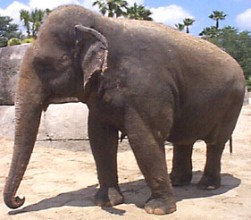 The Sri Lankan Asian Elephant lives only on the island of Sri Lanka (formerly Ceylon) south of India. This is the largest variety of Asian elephant, although there aren't very many of them (perhaps only 3000-4500).
The Sri Lankan Asian Elephant lives only on the island of Sri Lanka (formerly Ceylon) south of India. This is the largest variety of Asian elephant, although there aren't very many of them (perhaps only 3000-4500).
The Mainland Asian Elephant may be the most numerous (as many as 36,000), and live in many Asian countries, including India and Indonesia. The Sumatran Asian Elephant is one of the smallest of all elephants, with a height of only 3 metres at the shoulder and weighing just 4000 kg. They are almost as numerous as the Mainland Asians. This elephant lives only on the island of Sumatra. The Borneo Pygmy Elephant was recognized only in 2003 as a new subspecies; it is smaller and tamer than other Asian elephants, and lives in the jungles and forests on the island of Borneo. Facts About Elephants: 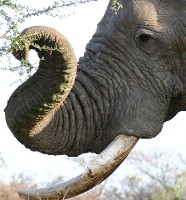
The elephant's trunk is an evolved adaptation that has fused the animal's nose and upper lip into an appendage that it can use to feed itself more efficiently. At the tip of the trunk are sensitive finger-like projections (two on African elephants, one on the Asian). An elephant's trunk has over forty thousand individual muscles in it, making it flexible enough to pick up a single blade of grass, yet strong enough to rip branches off trees. Elephants almost always use their trunks to tear up their food and then place it in their mouths. They feed on grass, or pull leaves or fruit off tree branches. Elephants will also grip the trunk of a tree to shake it to make leaves and branches fall, and will sometimes even knock a tree over to get at food which is too high to reach. 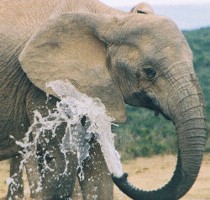 The elephant also uses its trunk for drinking. Elephants suck water into the trunk and then squirt it
into their mouth. Elephants also inhale water and mud to spray on their body while bathing (mud provides protection from the sun).
The elephant also uses its trunk for drinking. Elephants suck water into the trunk and then squirt it
into their mouth. Elephants also inhale water and mud to spray on their body while bathing (mud provides protection from the sun).
The elephant's trunk is also important for its social interactions. Elephants greet each other by twisting their trunks together, as if they were shaking hands. They also use them while playing, caressing during mating, and for displays of dominance - a raised trunk signifies a warning. An elephant also uses its trunk to smell. Raising the trunk up in the air and turning it from side to side allows an elephant to determine the location of friends, enemies, and food sources. 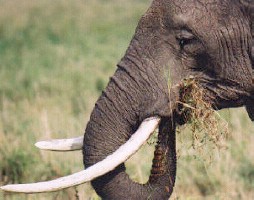 The tusks of an elephant are actually its upper incisor teeth, and while its other teeth are continually being replaced (up to five times), the tusks are permanent. Tusks are always growing, up to 18 cm per year for an adult male. Tusks are used to dig for water and roots, to remove bark from trees, and to clear a path through dense bush. They are also occasionally used in fights, as weapons. The tusks of an elephant are actually its upper incisor teeth, and while its other teeth are continually being replaced (up to five times), the tusks are permanent. Tusks are always growing, up to 18 cm per year for an adult male. Tusks are used to dig for water and roots, to remove bark from trees, and to clear a path through dense bush. They are also occasionally used in fights, as weapons.Elephants are often right- or left-handed, like humans, when it comes to their tusks. The dominant tusk is usually shorter and more rounded at the tip from wear. Both male and female African elephants have tusks that can be as long as 3 m and weigh over 90 kg. In the Asian species, only the males have large tusks; these can be as long as the Africans', but are usually thinner and lighter. Tusks are made of calcium phosphate (also known as ivory). Because this material is beautiful when carved and polished, desire for elephant ivory by humans has caused a dramatic decline of the world's elephant population. Despite being a protected species in many places, elephants continue to be killed in relatively large numbers by poachers, solely for the ivory in their tusks. When an elephant becomes very old, even if it still has its tusks, it will eventually be on its last set of teeth. As these become worn down to stumps, it will have trouble eating. Older elephants spend their days in marshy areas where they eat soft wet grasses that don't require much chewing. Eventually, when the last teeth fall out, the elephant won't be able to eat, and will die of starvation. 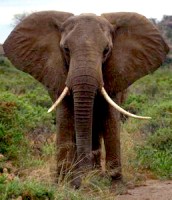 An elephant's skin is thick. Elephants are often referred to as pachyderms, which means 'thick-skinned animals'. An elephant's
skin is extremely tough, and is about 2.5 cm thick. (The skin around the mouth and inside of the ear, however, is paper thin).
Asian elephants, particularly young ones, generally have more hair than the African variety. An elephant's skin is thick. Elephants are often referred to as pachyderms, which means 'thick-skinned animals'. An elephant's
skin is extremely tough, and is about 2.5 cm thick. (The skin around the mouth and inside of the ear, however, is paper thin).
Asian elephants, particularly young ones, generally have more hair than the African variety. Elephants are usually grayish in colour. Though tough, an elephant's skin is very sensitive, and requires regular mud baths to keep it from getting sunburned. Elephants also spend a lot of time in water and mud to help them keep cool, since like all large animals they have proportionately less skin area relative to their body mass. Their large ears also help them to keep cool; flapping their ears cools the blood as it passes through them by as much as 10 degrees. This blood returns to the rest of the body to help cool it. (This also explains why African elephants have bigger ears ... it's hotter there). An elephant's legs are very thick because of the great mass they must support. African elephants almost never lie down unless they are sick, but Asian elephants lie down frequently. Elephants are the only mammals to have four knees. The feet of an elephant are round, and there is a thick layer of padding inside at the bottom; the elephant is actually standing on its toe bones on top of this pad. Elephants can swim well, and climb a little bit, but can't jump. An elephant's running gait (actually a quick walk) can reach 40 km/h. 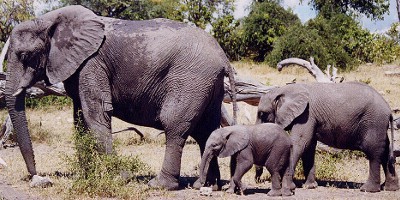 Elephants live in groups. Females spend their lives in close family groups made up of mothers, daughters, sisters, and aunts. These groups range from five to fifteen adults, along with immature males and females, and are led
by the eldest female, or matriarch. When a group gets too large, a few of
the oldest daughters will leave to form their own small group.
Elephants live in groups. Females spend their lives in close family groups made up of mothers, daughters, sisters, and aunts. These groups range from five to fifteen adults, along with immature males and females, and are led
by the eldest female, or matriarch. When a group gets too large, a few of
the oldest daughters will leave to form their own small group. Adult males, in contrast, live solitary lives. Younger males wander away from the group more and more as they get older, and they leave the group permanently by age fourteen to wander on their own, sometimes joining other males to make temporary male herds. Males spend a lot of time fighting with each other, although injuries are rare. Dominant males (usually ones who are forty to fifty years old) will get to mate with nearby females, who are sexually mature by the age of about ten to thirteen. An elephant's gestation period (pregnancy) lasts about 22 months, which is the longest of any mammal. Usually just one calf is born; newborn calves weigh about 100 kg, and stand about 75 cm tall. A newborn calf can stand within 30 minutes of birth, and is able to follow its mother, as the herd moves around, within a few days. Calves nurse from their mothers for up to 2 years, consuming as much as 11 litres of milk a day. Adult males will consume up to 300 kg of vegetation every day. More About Elephants Elephants can live as long as 70 years. An elephant expels about 50 litres of urine a day, and excretes up to 150 kg of dung. Elephants are one of the few species (such as humans, the great apes, and Bottlenose dolphins) that are capable of self-recognition ... they can recognize themselve in a mirror. They are also very social animals, and are aware of (and saddened by?) the death of another herd member. In addition to the normal sounds they make when close to each other, elephants can also communicate over long distances by using a sub-sonic rumbling noise; this has only recently been discovered. Elephants are also one of the few animals to use and manufacture simple tools. Elephants pick up objects and throw them. They use leafy branches to chase away flies , and short sticks to scrape lice out of their skin. They have even been observed to use a stick to short-out an electric fence. 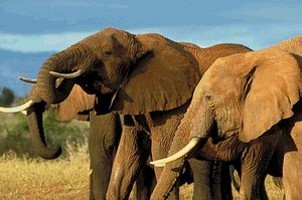 The killing of elephants by humans has had some strange
consequences. Ivory hunters, who kill only tusked elephants, have made it much easier for elephants with small
tusks or no tusks at all to mate. The killing of elephants by humans has had some strange
consequences. Ivory hunters, who kill only tusked elephants, have made it much easier for elephants with small
tusks or no tusks at all to mate. This artificial selection has caused a higher propagation of the 'absent-tusk' gene in the elephant, and has resulted in the birth of large numbers of tuskless elephants ... approaching 30% of the population in some regions, where the normal rate (pre-1930) was about 1%. Tusklessness, once very rare, has become a widespread hereditary trait. This is a perfect illustration of selection at work in the evolutionary process. |
